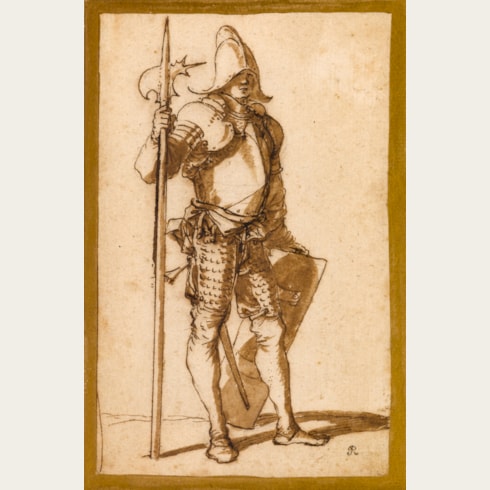Salvator ROSA
(Arenella 1615 - Rome 1673)
Four Men Moving a Boulder, with Two Onlookers
Numbered N33 on the verso and numbered 931 on the reverse of the old mount.
140 x 110 mm. (5 1/2 x 4 3/8 in.)
It is interesting to note that the present sheet has figured in the private collections of four different artists. The first known owner of the drawing was the English portrait painter Sir Thomas Lawrence (1769-1830), an obsessive and passionate collector who assembled probably the single greatest collection of Old Master drawings ever seen in England. The drawing later passed into the collection of Charles Fairfax Murray (1849-1919), a Victorian painter closely associated with the Pre-Raphaelites who collected Old Master and British drawings. The third owner of the present sheet was the artist, illustrator and printmaker Victor Winthrop Newman (b.1860), who may have bought the drawing at auction in New York in 1924. At the auction of Newman’s collection six years later, the present sheet was acquired by Ernest Clifford Peixotto (1869-1940), an American mural painter and illustrator who studied at the Académie Julien in Paris before joining the staff of Scribner’s Magazine, although he lived in France for most of his life, at Fontainebleau. While he began his career as an illustrator, Peixotto worked mainly as a mural painter from 1911 onwards.
Rosa was a remarkable draughtsman, and his spirited, exuberant drawings were highly praised by connoisseurs even in his own day. The bulk of the nine hundred or so surviving drawings by the artist are figure studies, usually in his preferred medium of pen and ink, and often enlivened with touches of wash. Many of the drawings from the early part of his career are signed, and these may have been sold to collectors or presented as gifts to friends or patrons. However, almost no signed drawings dating from after 1649 exist, and it has been suggested that, after his return to Rome, Rosa chose to keep most of his drawings for himself, and not part with them.
Provenance
Purchased after Lawrence’s death, together with the rest of his collection, by Samuel Woodburn, London, in 1834
Possibly his posthumous Woodburn sale (‘The Valuable and Important Collection of Drawings, By the Old Masters, Formerly in the Collection of the Late Sir Thomas Lawrence, P.R.A., And more recently the Property of that Distinguished Connoisseur, Samuel Woodburn Esq., Deceased’), London, Christie’s, 4-8 June 1860 [lot unidentified]
Charles Fairfax Murray, London
Thence by descent
The posthumous Fairfax Murray sale (‘Drawings by the Old Masters from the Collections of Richard Ederheimer, New York, and the late Fairfax Murray, London, England’), New York, Anderson Galleries, 6-7 November 1924, lot 300 (‘Salvatore Rosa 1615-1673. Group of Six Men. Four of them kneeling. Characteristic pen drawing. Height, 4 5/8 inches; width, 4 3/4 inches’)
Victor Winthrop Newman, London and New York
His sale, New York, American Art Association, Anderson Galleries, 4 December 1930, lot 180
Ernest Clifford Peixotto, Fontainebleau and New York
By descent to his daughter
William Doyle Galleries, New York [sale unidentified]
Mia Weiner, New York, in 1990
Acquired in 1994 by John O’Brien, Charles Town, West Virginia (Lugt 4230), his handwritten collector’s mark O’ inscribed in pencil on the reverse of the old mount.
Literature
Exhibition









